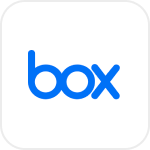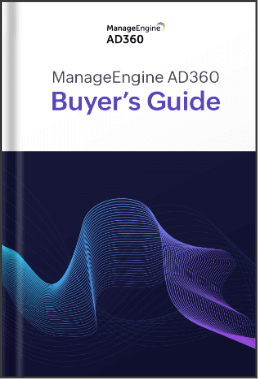
- Overview
- Configuration
Box
Automate Box user management with ADManager Plus integration
Box is a cloud-based content management and collaboration platform that helps organizations securely store, manage, and share files, improving team collaboration, workflow efficiency, and data governance across the enterprise. Integrating Box with ManageEngine ADManager Plus allows organizations to streamline the management of user accounts and permissions across both platforms. This integration automates user provisioning and keeps user details synchronized between Box and Active Directory, ensuring consistent and up-to-date information across all systems.
Automate user creation
When new employees are onboarded, ADManager Plus automatically provisions their user accounts in Active Directory, and this integration ensures that corresponding accounts are also created in Box. This automation guarantees that new users are granted timely access to Box’s cloud storage and collaboration tools, aligned with their roles and permissions in AD.
Synchronize user changes
ADManager Plus lets IT teams to set up workflows to mirror updates to user details in Active Directory like changes in roles, departments, or contact information to automatically synchronize with Box.
Need assistance to integrate Sage with ADManager Plus?
How to integrate ADManager Plus and Box
Prerequisites
Box uses OAuth2.0 to authorize API requests. You'll need to have the client_id and client_secret to retrieve desired information and perform tasks in Box. Refer to Box's API documentation for more details.
Privileges
To import users from Box (inbound action): Ensure the account used for authentication has permission to read all user accounts.
To perform any action or query in Box (outbound action): Ensure the account used for authorization has permission to perform the desired action.
Note: ADManager Plus comes with a preconfigured set of APIs that help perform basic actions with the integration. If the action you require is not available, please gather the necessary API details from Box's API documentation to configure inbound or outbound webhooks to perform the required actions.Authorization configuration
- Log in to ADManager Plus and navigate to the Automation tab.
- In the left pane, under Configuration, click Application Integrations.
- Under Enterprise Applications, click Box.
- Toggle the Enable Box Integration button on.
- On the Box Configuration page, click Authorization.
- Enter the client_id and client_secret values generated in Box into the respective fields.
- Click Configure.
Inbound webhook configuration
Inbound webhooks enable you to fetch user data from Box and send it to ADManager Plus. The attribute mapping configured in this section can be selected as the data source during automation configuration to perform the desired action on the list of users received from the API response. To configure an inbound webhook for Box:
- Under Inbound Webhook, click Box Endpoint Configuration.
- In the Endpoint Configuration tab, an endpoint, Box USERS ENDPOINT, comes preconfigured with Endpoint URL, API Method, Headers, and Parameters fields to fetch user accounts from Box. However, if you would like to use a new endpoint to import users, you can configure one using the + Add API endpoint button and filling in the required fields as per Box's API documentation. Click here to learn how.
- The API key value pair is preconfigured as a header for authenticating API requests as configured during authorization configuration.
- Macros: You can add macros to your endpoint configuration to dynamically change it as per your requirements using the macro chooser component.
- Refer to Box's API documentation and configure additional headers and parameters, if required.
- Once done, click Test & Save. A response window will display all the requested parameters that can be fetched using the API call. Click Proceed.
- Refer to Box's API documentation to learn about the parameters that must be configured to fetch only specific parameters.
- You can configure multiple endpoints for Box using the + Add API endpoint button. Click here to learn how.
- Click Data Source - LDAP Attribute Mapping to match endpoints and to map AD LDAP attributes with the respective attributes in Box.
- Click + Add New Configuration and perform the following:
- Enter the Configuration Name and Description and select the Automation Category from the drop-down menu.
- In the Select Endpoint field, select the desired endpoint and a Primary Key that is unique to a user (e.g. employeeIdentifier).
- In the Attribute Mapping field, select the attribute from the LDAP Attribute Name drop-down menu and map it with the respective column in Box.
- If you would like to create a new custom format for this, click Mapping Attribute.
- Click Save.
- Under Outbound Webhook, click Box Webhook Configuration.
- Click + Add Webhook.
- Enter a name and description for this webhook.
- Decide on the action that has to be performed and refer to Box's API documentation for the API details, such as URL, headers, and parameters.
- Select the HTTP method that will enable you to perform the desired action on the endpoint from the drop-down menu.
- Enter the endpoint URL.
- Configure the Headers, Parameters, and Message Type in the appropriate format based on the API call that you would like to perform.
- Click Test and Save.
- A pop-up window will then display a list of AD users and groups to test the configured API call. Select the desired user or group over which this API request has to be tested and click OK. This will make a real-time call to the endpoint URL, and the selected objects will be modified as per the configuration.
- The webhook response and request details will then be displayed. Verify them for the expected API behavior and click Save.
Note:
Note:
[ADManager Plus also lets you customize attribute format from Box.]
Note: When multiple endpoints are configured, this attribute must hold the same value in all the endpoints.
Outbound webhook configuration
Outbound webhook enables you to send changes made in AD to Box, and carry out tasks in Box—all from ADManager Plus. The webhooks configured in this section can be included in Orchestration Templates, which in turn can be used during event-driven and scheduled automations. They can also be applied directly on desired users to perform a sequence of actions on them (Management > Advanced Management > Orchestration).To configure outbound webhooks for Box:

